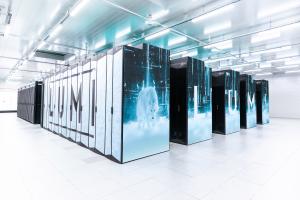CSC - IT Center for Science not only oversees two national supercomputers that fuel research and innovation in its home country of Finland, but also manages the LUMI supercomputer, which became Europe’s most powerful supercomputer in 2022.
In 2021, CSC began integrating the Ohio Supercomputer Center’s (OSC) Open OnDemand portal into its high performance computing environments, first with Finland’s Puhti supercomputer, which supports research and education needs for a wide range of science domains. CSC's use of Open OnDemand expanded to the Mahti supercomputer in 2023, and soon after to LUMI. LUMI is one of the pan-European pre-exascale supercomputers of the European High Performance Computing Joint Undertaking (EuroHPC JU), hosted by the LUMI consortium with 11 European countries at CSC’s data center in Kajaani, Finland.

“Open OnDemand has been very popular at CSC,” said Simon Westersund, systems administrator. “It debuted in September 2021, and in the first year we already had reached 200 unique users. Since then it's grown a lot. This has contributed to our interest in being involved in the Open OnDemand community, as it’s becoming a big part of how our users are using our supercomputers.”
CSC discovered Open OnDemand, which is supported by funding from the National Science Foundation, during a session at the 2019 Supercomputing Conference in Denver, Colo., that provided an overview of the portal’s capabilities and possibilities, said Sebastian von Alfthan, computing environments group leader. After comparing it to other available solutions, the Center decided to use Open OnDemand with all of its systems, testing it on Puhti to determine how it interfaced with the cluster’s applications. The web interface received good feedback from users, especially from less experienced ones, von Alfthan said.
Each of the three supercomputers now has four Open OnDemand environments of its own. This allows the CSC staff to manage testing, staging, production and future developments, Westersund said.

Since implementation of Open OnDemand, about 50 percent of users of Puhti are actively engaging with the web portal, and some are using it as their main interface to the systems, von Alfthan said. Open OnDemand has provided ease of access for new users with no Linux experience, as well as for participants in academic courses. Other benefits include the capability for users to run customized Jupyter environments, accelerated graphics that enable scientific visualizations, and improved management of cloud storage and data transfer.
CSC also has appreciated OSC’s responsiveness to feedback and integration of the Center’s suggestions into the Open OnDemand platform. The CSC team developed new remote file browsing capabilities (Rclone integration) that were featured in the Open OnDemand 3.0 version release.
“We receive very good support from OSC on improving Open OnDemand and adding features,” von Alfthan said. “We have a real ability to affect the solutions, which means we can adopt it with greater confidence and do long-term planning. This has enabled CSC to develop new features that provide key capabilities we require.”
The Ohio Supercomputer Center (OSC) addresses the rising computational demands of academic and industrial research communities by providing a robust shared infrastructure and proven expertise in advanced modeling, simulation and analysis. OSC empowers scientists with the services essential to making extraordinary discoveries and innovations, partners with businesses and industry to leverage computational science as a competitive force in the global knowledge economy and leads efforts to equip the workforce with the key technology skills required for 21st century jobs.